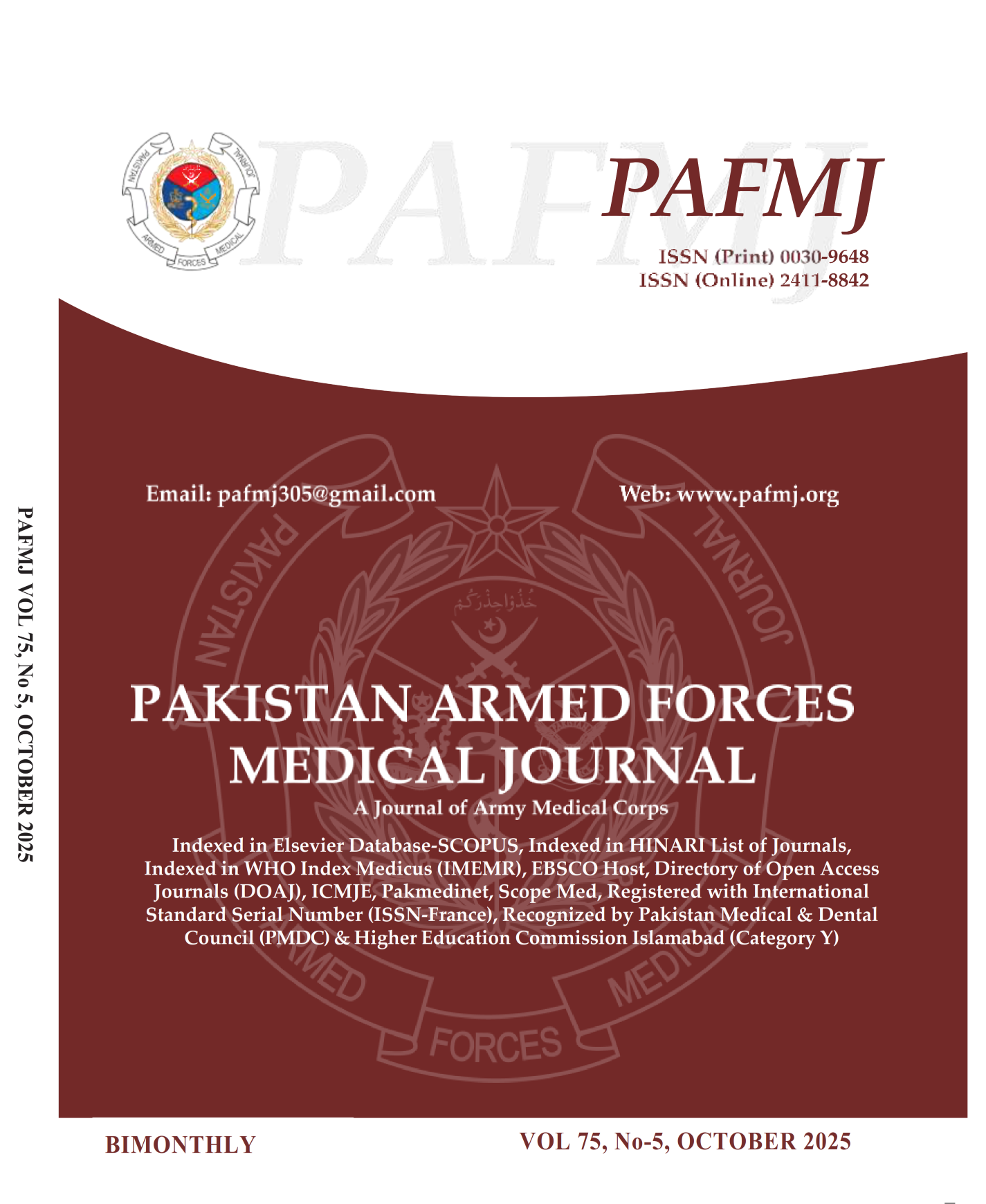Role of Preoperative Intravenous Steroid Injection in Preventing Seroma Formation After Breast Surgeries
DOI:
https://doi.org/10.51253/pafmj.v75i5.11734Keywords:
Breast Surgery, Depomedrol, Methylprednisolone, Seroma, SteroidsAbstract
Objective: To evaluate the role of preoperative intravenous steroid injection in preventing seroma formation after breast surgeries.
Study Design: Quasi-experimental study.
Place and Duration of Study: Pak Emirates Military Hospital, Rawalpindi Pakistan, from Jul to Dec 2023.
Methodology: With non-probability consecutive sampling technique, a total of 40 patients were included who were scheduled for breast surgeries. 20 patients were grouped into Group-I who were not given steroid before surgery. Group-II also consisted of 20 patients who were injected 120 mg intravenous injection of methylprednisolone one hour prior to surgery. Post-surgery the amount of drainage and number of drainage days were recorded in milliliters. At each follow up visit, wound was also examined for any infection or necrosis.
Results: Patients ranged in age from 18 to 69 years, with a mean age of 56.83+6.91. Methylprednisolone injection given to the patients of Group-II helped reduce the average drain output and number of days for which drainage was required and was statistically significant. 25% of patients reported with seroma formation in Group-II and only 5% of which underwent surgical/ IR guided intervention as compared to 45% in Group-I with 15% undergoing surgical/ IR guided intervention.
Conclusion: A single dose of intravenous steroid injection (methylprednisolone) given an hour before surgery is a promising and effective strategy to prevent seroma formation following breast surgical procedures without any significant complications or side effects.
Downloads
References
M, et al. Current and future burden of breast cancer: Global statistics for 2020 and 2040. Breast 2022; 66(1): 15-23.
https://doi.org/10.1016/j.breast.2022.08.010
2. Ali MM, Khokhar MA, Ahmed HN. Primary care physicians and cancer care in Pakistan: A short narrative. J Cancer Policy 2020; 25: 100238. https://doi.org/10.1016/j.jcpo.2020.100238
3. Labisso WL, Leka Y, Leka Y, Haileselassie W. A descriptive cross-sectional study on awareness and belief of people about cancer in Southern Ethiopia: special focus on breast and cervical cancers. Risk Manag Healthcare Policy 2020: 19: 2655-2668.
https://doi.org/10.2147/rmhp.s267207
4. Jabeen Z, Shah N, Ahmer Z, Khan S, Khan AH, Khan M. Effect of health education on awareness and practices of breast self-examination among females attending a charitable hospital at North Karachi. J Pak Med Assoc 2021; 71(9): 2156-2162.
https://doi.org/10.47391/JPMA.04-564
5. Ramakrishnan R. Staging and Surgical Management of Breast Cancer. In Holistic Approach to Breast Disease. Springer Nature Singapore: 2023; pp. 327-339.
6. Wedgwood KR, Benson EA. Non-tumour morbidity and mortality after modified radical mastectomy. Ann Royal Coll Surg En 1992; 74(5): 314-317.
7. Pochert N, Schneider M, Köpke MB, Wild M, Mattmer A, Sagasser J, et al. Th2/Th17 cell associated cytokines found in seroma fluids after breast cancer surgery. Arch Gynecol Obstet 2023; 308(5): 1621-1627.
https://doi.org/10.1007/s00404-023-07074-w
8. Sampathraju S, Rodrigues G. Seroma formation after mastectomy: pathogenesis and prevention. Indian J Surg Oncol 2010; 1: 328-333.
https://doi.org/10.1007/s13193-011-0067-5
9. Srivastava V, Basu S, Shukla VK. Seroma formation after breast cancer surgery: what we have learned in the last two decades. J Breast Cancer 2012; 15(4): 373.
https://doi.org/10.4048/jbc.2012.15.4.373
10. Holte K, Kehlet H. Perioperative single-dose glucocorticoid administration: pathophysiologic effects and clinical implications. J Am Coll Surg 2002;195(5): 694-712.
https://doi.org/10.1016/s1072-7515(02)01491-6
11. Schulze S, Andersen J, Overgaard H, Nørgaard P, Nielsen HJ, Aasen A, et al. Effect of prednisolone on the systemic response and wound healing after colonic surgery. Arch Surg 1997; 132(2): 129-135. https://doi.org/10.1001/archsurg.1997.01430260027005
12. Sakkary MA. The value of mastectomy flap fixation in reducing fluid drainage and seroma formation in breast cancer patients. World J Surg Oncol 2012; 10: 1-6.
https://doi.org/10.1186/1477-7819-10-8
13. Subramanian P, Arumugam M, Vaithianathan R. Role of methylprednisolone in the prevention of seroma formation after mastectomy: A randomized controlled trial. Indian J Cancer 2023; 60(2): 206-210. https://doi.org/10.4103/ijc.IJC_1008_20
14. Iqbal MN, Usman A, Aftab S, Ali M, Azeem SM, Najeeb W. Effect of Preoperative Steroid Injection on Wound Drainage after Modified Radical Mastectomy. Pak J Med Health Sci 2023; 17(04): 394. https://doi.org/10.53350/pjmhs2023174394
15. Fatima S, Shafique MS, Shabana B, Nawaz S, Khan JS, Hasan SW. The Prevention of Seroma Formation Following Modified Radical Mastectomy by Intravenous Hydrocortisone Injection. Cureus 2024; 16(2): 55017. https://doi.org/10.7759/cureus.55017
16. Khan MA. Effect of preoperative intravenous steriods on seroma formation after modified radical mastectomy. J Ayub Med Coll Abbottabad 2017; 29(2): 207-210.
17. Seth US, Perveen S, Khan I, Ahmed T, Kamal MT, Khomusi MM. Effect of preoperative intravenous steroids on seroma formation after modified radical mastectomy. J Pak Med Assoc 2023; 73(1): 69-73. https://doi.org/10.47391/jpma.6112
18. Nischal RL, Saeed A, Arpitha MR, Sumalatha A, Avinash TR. A study on local injection of methylprednisolone acetate to prevent seroma formation after mastectomy in 210 cases. J Population Ther Clin Pharmacol 2024; 31(2): 2528-2535.
https://doi.org/10.53555/jptcp.v31i2.4655
19. Shiraz DA, Qazi M, Sabir I, Jameel MK, Aqeel CM, Muneer M. Methylprednisolone for Prevention of Seroma Formation after Mastectomy. Pak J Med Health Sci 2022; 16(12): 203-205.
Downloads
Published
Issue
Section
License
Copyright (c) 2025 Shaza Bashir, Syed Mukarram Hussain, Waseem Ahmad Khan, Muhammad Ahmad, Adil Maqbool, Fawad Anwar

This work is licensed under a Creative Commons Attribution-NonCommercial 4.0 International License.















